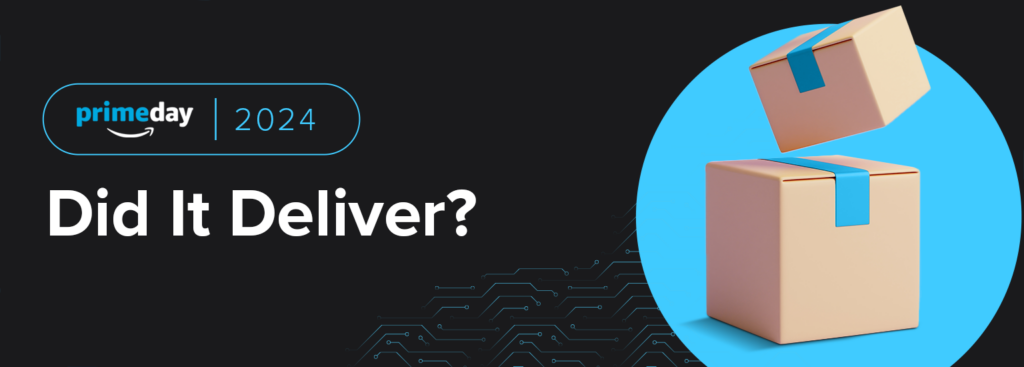Since its inception in 2015, Prime Day has been positioned as one of the biggest shopping days of the year, coming in after the likes of Black Friday and Cyber Monday. As the world continues to shift towards the convenience of online shopping, Prime Day has enabled Amazon to encourage higher rates of purchase as well as increase memberships to its Prime loyalty program.
Prime Day has come up against a few hurdles in the last four years. In 2020, supply chain issues meant that even the surge in online shopping demand necessitated by the pandemic couldn’t pull sales figures back to the highs seen in 2016 and 2017. Then, in 2021, we saw an increase in global inflation rates, and the sales figures for Prime Day ‘21 and ‘22 were also muted in success. Then, the 2023 edition was marred by a string of similarly-timed sales at leading retailers like Walmart and Target.
In a greater market sense, it’s clear that shopper concerns around inflation and economic instability are driving a change in shopping behaviors. They are exerting significant pressure on the price-to-value ratio, leading to a noticeable trend of shoppers opting for private labels. According to our data, purchase intent and traffic have increased across the PriceSpider network, while purchase rates and average order values have remained flat. Heading into Prime Day 2024, this did not bode well.
The data and associated insights in this post are derived from our industry-leading Where to Buy solution platform.
Lead Conversion Rate
We tracked a 75% increase in Lead Conversion Rates across the two days of Prime Day this year when compared to the 2023 sale. An increase this large could be attributed to a number of factors, including improved targeting efforts, enhanced user experiences, personalization, higher quality leads, automation tools, refined messaging, and increased brand trust. The Lead Conversion Rate was higher on 07/16 than it was on 07/17, which can be attributed to initial excitement and urgency, product availability, time-specific marketing activities, and fluctuations in perceived deal quality. On 07/16, the Lead Conversion Rate was 13.6%, which fell to 13.1% on 07/17.
Purchase Rate
Of the 13 categories that we analyzed, 9 saw an increase in Purchase Rate during the Prime Day 2024 sale compared to the same event in 2023. The Purchase Rate for two of those categories (Toys & Games and Sports & Outdoors) almost doubled, and one (Automotive) has seen a threefold increase. The overall Purchase Rate average across these specific categories was 5.9%. This is especially impressive when we keep in mind that the average Purchase Rate across e-commerce categories is between 2.5% and 3%.
The four categories that saw a Purchase Rate decrease were Hardware, Household Goods & Grocery, Consumer Electronics, and Lawn/Garden/Patio.
AOV (Average Order Value)
Of those same 13 categories, 7 saw an increase in AOV during the 2024 Prime Day Sales compared to the same event in 2023. However, the AOV from 2023 to 2024 saw a decrease of 5.47% overall. The Hardware, Household Goods & Grocery, Consumer Electronics, Health & Beauty, Automotive, and Baby categories all saw decreases.
The average increase between the 7 other categories was 19.27%, which is a very encouraging figure. The biggest category increase was Lawn/Garden/Patio with 39.71%, and the lowest was Pet Supplies with 1.89%.
Improvement Opportunities
As seen in these data insights, there are some key takeaways that brands can use to adapt their sales strategies for the next Prime Big Deal Days sale (October 11-12) and can also use as they plan for Black Friday and Cyber Monday. Starting with the discrepancy in Purchase Rate between Day 1 and Day 2 of the 2024 Prime Day sale, retailers need to focus efforts on maximizing deal exposure for subsequent sales days. By introducing new deals on Day 2, offering bigger discounts on lower-stock items, and renewing marketing campaigns tailored to deals being introduced on Day 2, brands can boost their overall Purchase Rates.
MAP Violations also play a part in the overall success of a sale for brands. According to our PROWL MAP solution, we tracked 264,646 MAP violations between (and including) 07/16 and 07/17. If MAP violations are not remedied, the market will see price erosion, damaged retailer-brand relationships, diminished brand perception and dented customer trust.

